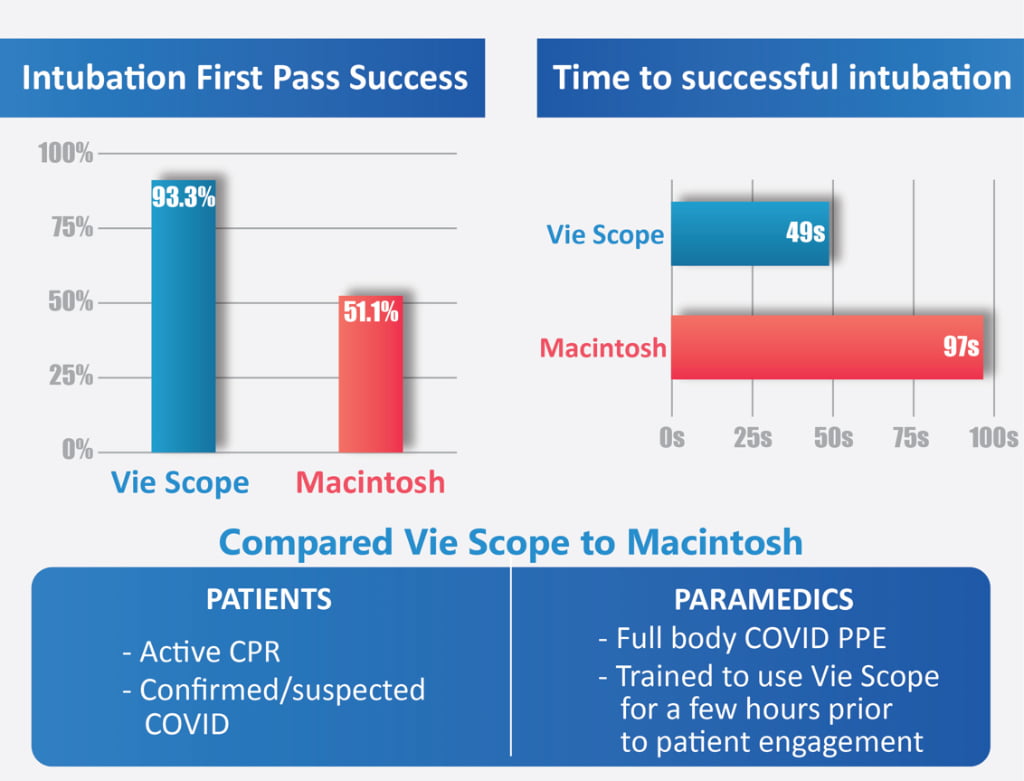
Comparison of FPS and Intubation Time
A recent prehospital clinical study published in the American Journal of Emergency Medicine has shown that intubation first-pass success (FPS) with the Vie Scope® was essentially doubled compared to standard intubation methods.
Szarpak et al. evaluated paramedics in Warsaw, Poland, during the height of the COVID pandemic wave who were randomized to intubate patients during cardiopulmonary resuscitation (CPR) with either the standard Macintosh laryngoscope or the Vie Scope®. All paramedics were equipped and wearing full PPE during patient encounters. Paramedics were all experienced users of Macintosh laryngoscopes and only trained to use the Vie Scope® over a few hours before using it in the field. Despite the short learning curve, users of the Vie Scope® had a FPS of 93.3% compared to 51.1% with the Macintosh laryngoscope and cut intubation time in half from 97 to 49 seconds.
Nilesh R. Vasan, MD, CEO and founder of Adroit Surgical, elaborated on the clinical implications this has on intubation standard of care. “Failure to achieve intubation on the first attempt, no matter the location, has serious consequences for the patient, including hypoxic brain injury and death. The Vie Scope® method of securing the airway, even in difficult airway cases, is easy to learn and perform and gives everyone the best opportunity to achieve intubation first-pass success.”
Prof. Szarpak said: “We were surprised by the large performance gap between the Vie Scope, a bougie introducer and the Macintosh laryngoscope. We know that paramedics find the Vie Scope easy to use compared to the traditional Macintosh direct laryngoscope and that the light and view through the scope gives them easy access to the vocal cords. What was more surprising is the fact that, despite the Vie Scope requiring an extra step, the use of a bougie, the average time to intubation was still half that of the Macintosh laryngoscope.”
Dr. Vasan also noted the intubation time was half (49 sec) that of the Macintosh laryngoscope (97 sec), which demonstrates that even with the bougie, FPS is easily achieved in critical care patients requiring CPR. “There has been a move away from endotracheal intubation (ETI) and replace it with supraglottic airway devices (SGA) because it’s perceived to be easier. Supraglottic devices have their own complications and contraindications, especially in the prehospital environment. The push to use video laryngoscopy in prehospital care has also not resulted in any meaningful benefit compared to the Macintosh laryngoscope. Intubation in the field is always a challenge but this study has proven that novice users with minimal training treating proven or suspected COVID patients requiring CPR whilst wearing full body PPE resulted in intubation first-pass success close to 95%. With all the complications associated with failed intubation attempts there is no reason not to use the Vie Scope®,” said Dr. Vasan.

